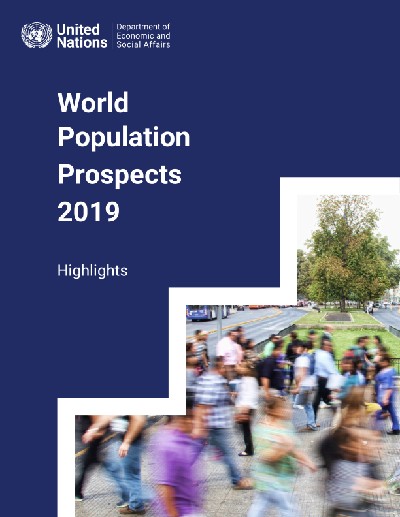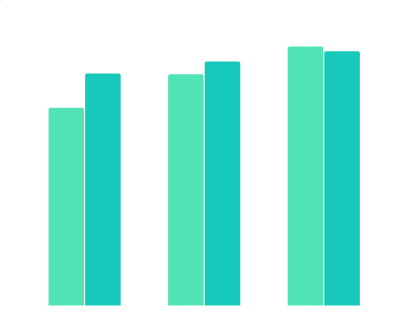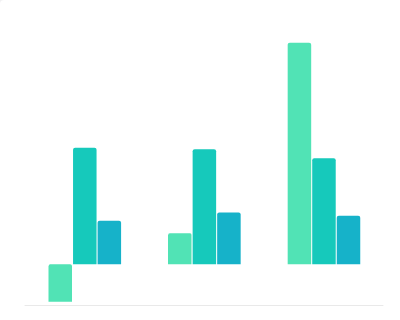"世界人口权威数据报告"相关数据
更新时间:2024-11-292019年世界人口展望
Understanding global population trends and anticipating the demographic changes to come are crucial to the achievement of the 2030Agenda for Sustainable Development. The 2030Agenda emphasizes that people are at the centre of sustainable development,echoing the ideals set forth in the Programme of Action of the International Conference on Population and Development adopted in Cairo in 1994.Population trends observed over the past few decades point to substantial progress made towards several of the Sustainable Development Goals (SDGs) so far.Examples include reduced mortality,particularly among children,as well as increased access to sexual and reproductive health care and enhanced gender equality that have empowered women to decide freely and responsibly the number,spacing and timing of their children.
Recent demographic trends are harbingers of the future challenges to sustainable development. For example,countries experiencing rapid population growth,most of which are in sub-Saharan Africa,must provide schooling and health care to growing numbers of children,and ensure education and employment opportunities to increasing numbers of youth. Countries where population growth has slowed or stopped must prepare for an increasing proportion of older persons and, in some cases,decreasing population size. These and other challenges can be addressed in part by anticipating coming demographic trends and incorporating that information into policies and planning.
The United Nations population estimates and projections form a comprehensive set of demographic data to assess population trends at the global, regional and national levels. They are used in the calculation of many of the key development indicators commonly used by the United Nations system,including for more than one third of the indicators used to monitor progress towards the achievement of the sDGs. The 2019 revision of the World Population Prospects is the twenty-sixth edition of the United Nations population estimate sand projections,which have been prepared since1951 by the Population Division of the Department of Economic and Social Affairs.The 2019 revision presents population estimates from 1950 until the present for 235 countries or areas, which have been developed through country-specific analyses of historical demographic trends. It builds on previous revisions by incorporating additional results from the 2010 and 2020 rounds of national population censuses as well as information from vital registration and recent nationally representative household surveys.The 2019 revision also presents population projections to the year 2100 that reflect a range of plausible outcomes at the global, regional and country levels.
【更多详情,请下载:2019年世界人口展望】

 截至2006年世界人口贩运被害人类型该统计数据包含了截至2006年世界人口贩运被害人类型。女性占比高达79%,其中妇女占66%,女孩占13%。2006年发布时间:2020-08-31
截至2006年世界人口贩运被害人类型该统计数据包含了截至2006年世界人口贩运被害人类型。女性占比高达79%,其中妇女占66%,女孩占13%。2006年发布时间:2020-08-31 1990-2100E世界人口总数增长情况该统计数据包含了1990-2100E世界人口总数增长情况。预计世界人口在未来15年内将增加超过10亿,到2030年将达到85亿,之后人口将继续增长,于2050年达到97亿,到2100年达到112亿。1990-2100年发布时间:2020-07-03
1990-2100E世界人口总数增长情况该统计数据包含了1990-2100E世界人口总数增长情况。预计世界人口在未来15年内将增加超过10亿,到2030年将达到85亿,之后人口将继续增长,于2050年达到97亿,到2100年达到112亿。1990-2100年发布时间:2020-07-03 截至2020年4月世界人口排名Top10该统计数据包含了截至2020年4月世界人口排名Top10。中国人口数量为1400050000人,名列第一位。2020年发布时间:2020-06-04
截至2020年4月世界人口排名Top10该统计数据包含了截至2020年4月世界人口排名Top10。中国人口数量为1400050000人,名列第一位。2020年发布时间:2020-06-04 公元前1万年-2021年世界人口数量该统计数据包含了公元前1万年-2021年世界人口数量。2021年全球的人口数量已经接近79亿人。2021年发布时间:2022-06-06
公元前1万年-2021年世界人口数量该统计数据包含了公元前1万年-2021年世界人口数量。2021年全球的人口数量已经接近79亿人。2021年发布时间:2022-06-06 1963-2016年中国与世界人均预期寿命历史变化情况该数据包含了1963-2016年中国与世界人均预期寿命历史变化情况。2016中国预期寿命(岁)为76.3岁,世界预期寿命(岁)为72.0岁。1963-2016年发布时间:2019-07-11
1963-2016年中国与世界人均预期寿命历史变化情况该数据包含了1963-2016年中国与世界人均预期寿命历史变化情况。2016中国预期寿命(岁)为76.3岁,世界预期寿命(岁)为72.0岁。1963-2016年发布时间:2019-07-11 1961年-2013年世界人均肉类食用量该统计数据包含了1961年-2013年世界人均肉类食用量。截至2013年全球人均肉类消耗量达到43千克。1961-2013年发布时间:2021-02-07
1961年-2013年世界人均肉类食用量该统计数据包含了1961年-2013年世界人均肉类食用量。截至2013年全球人均肉类消耗量达到43千克。1961-2013年发布时间:2021-02-07 2011-2017年中国耕地面积及中国与世界人均耕地面积该统计数据包含了2011-2017年中国耕地面积及中国与世界人均耕地面积。2017年中国耕地面积达到了20.23亿亩,中国人均耕地面积达到了1.455亩/人。2011-2017年发布时间:2021-02-05
2011-2017年中国耕地面积及中国与世界人均耕地面积该统计数据包含了2011-2017年中国耕地面积及中国与世界人均耕地面积。2017年中国耕地面积达到了20.23亿亩,中国人均耕地面积达到了1.455亩/人。2011-2017年发布时间:2021-02-05 2017年世界主要国家15-64岁人口占比情况该统计数据包含了2017年世界主要国家15-64岁人口占比情况。中国的15-64岁人口占比71.7%,世界占比65.4%。2017年发布时间:2019-07-11
2017年世界主要国家15-64岁人口占比情况该统计数据包含了2017年世界主要国家15-64岁人口占比情况。中国的15-64岁人口占比71.7%,世界占比65.4%。2017年发布时间:2019-07-11 1960年-2018年世界各国人口自然增长率该统计数据包含了1960年-2018年世界各国人口自然增长率。其中,日本2018年人口自然增长率达到-3.6%1960-2018年发布时间:2021-01-14
1960年-2018年世界各国人口自然增长率该统计数据包含了1960年-2018年世界各国人口自然增长率。其中,日本2018年人口自然增长率达到-3.6%1960-2018年发布时间:2021-01-14 截至2020年9月全球宽带下载速度该统计数据包含了截至2020年9月全球宽带下载速度。其中新加坡的宽带下载速度最快。2020年发布时间:2021-02-24
截至2020年9月全球宽带下载速度该统计数据包含了截至2020年9月全球宽带下载速度。其中新加坡的宽带下载速度最快。2020年发布时间:2021-02-24 1970-2018年埃及总人口支付给世界其他国家的外国收入总计(个人)该数据包含了1970-2018年埃及总人口支付给世界其他国家的外国收入总计(个人)。其中2018年为233094610944。1970-2018年发布时间:2022-10-13
1970-2018年埃及总人口支付给世界其他国家的外国收入总计(个人)该数据包含了1970-2018年埃及总人口支付给世界其他国家的外国收入总计(个人)。其中2018年为233094610944。1970-2018年发布时间:2022-10-13 1970-2019年以色列总人口支付给世界其他国家的外国收入总计(个人)该数据包含了1970-2019年以色列总人口支付给世界其他国家的外国收入总计(个人)。其中2019年为90981556224。1970-2019年发布时间:2022-10-08
1970-2019年以色列总人口支付给世界其他国家的外国收入总计(个人)该数据包含了1970-2019年以色列总人口支付给世界其他国家的外国收入总计(个人)。其中2019年为90981556224。1970-2019年发布时间:2022-10-08 1970-2019年爱尔兰总人口支付给世界其他国家的外国收入总计(个人)该数据包含了1970-2019年爱尔兰总人口支付给世界其他国家的外国收入总计(个人)。其中2019年为219654963200。1970-2019年发布时间:2022-09-16
1970-2019年爱尔兰总人口支付给世界其他国家的外国收入总计(个人)该数据包含了1970-2019年爱尔兰总人口支付给世界其他国家的外国收入总计(个人)。其中2019年为219654963200。1970-2019年发布时间:2022-09-16 1970-2018年泰国总人口支付给世界其他国家的外国收入总计(个人)该数据包含了1970-2018年泰国总人口支付给世界其他国家的外国收入总计(个人)。其中2018年为1496683380736。1970-2018年发布时间:2022-09-16
1970-2018年泰国总人口支付给世界其他国家的外国收入总计(个人)该数据包含了1970-2018年泰国总人口支付给世界其他国家的外国收入总计(个人)。其中2018年为1496683380736。1970-2018年发布时间:2022-09-16 1960-2018年挪威总人口支付给世界其他国家的外国收入总计(个人)该数据包含了1960-2018年挪威总人口支付给世界其他国家的外国收入总计(个人)。其中2018年为285655597056。1960-2018年发布时间:2022-09-16
1960-2018年挪威总人口支付给世界其他国家的外国收入总计(个人)该数据包含了1960-2018年挪威总人口支付给世界其他国家的外国收入总计(个人)。其中2018年为285655597056。1960-2018年发布时间:2022-09-16 1950-2018年菲律宾总人口支付给世界其他国家的外国收入总计(个人)该数据包含了1950-2018年菲律宾总人口支付给世界其他国家的外国收入总计(个人)。其中2018年为760321998848。1950-2018年发布时间:2022-09-16
1950-2018年菲律宾总人口支付给世界其他国家的外国收入总计(个人)该数据包含了1950-2018年菲律宾总人口支付给世界其他国家的外国收入总计(个人)。其中2018年为760321998848。1950-2018年发布时间:2022-09-16 1960-2019年奥地利总人口支付给世界其他国家的外国收入总计(个人)该数据包含了1960-2019年奥地利总人口支付给世界其他国家的外国收入总计(个人)。其中2019年为30375790592。1960-2019年发布时间:2022-10-13
1960-2019年奥地利总人口支付给世界其他国家的外国收入总计(个人)该数据包含了1960-2019年奥地利总人口支付给世界其他国家的外国收入总计(个人)。其中2019年为30375790592。1960-2019年发布时间:2022-10-13 1987-1994年新加坡总人口员工从世界其他地区获得的报酬总计(个人)该数据包含了1987-1994年新加坡总人口员工从世界其他地区获得的报酬总计(个人)。其中1994年为-206575440。1987-1994年发布时间:2023-03-31
1987-1994年新加坡总人口员工从世界其他地区获得的报酬总计(个人)该数据包含了1987-1994年新加坡总人口员工从世界其他地区获得的报酬总计(个人)。其中1994年为-206575440。1987-1994年发布时间:2023-03-31 1995-2019年西班牙总人口来自世界其他地方的产品补贴总计该数据包含了1995-2019年西班牙总人口来自世界其他地方的产品补贴总计。其中2019年为70193432。1995-2019年发布时间:2022-08-12
1995-2019年西班牙总人口来自世界其他地方的产品补贴总计该数据包含了1995-2019年西班牙总人口来自世界其他地方的产品补贴总计。其中2019年为70193432。1995-2019年发布时间:2022-08-12 1995-2019年荷兰总人口来自世界其他地方的产品补贴总计该数据包含了1995-2019年荷兰总人口来自世界其他地方的产品补贴总计。其中2019年为1030142。1995-2019年发布时间:2022-08-09
1995-2019年荷兰总人口来自世界其他地方的产品补贴总计该数据包含了1995-2019年荷兰总人口来自世界其他地方的产品补贴总计。其中2019年为1030142。1995-2019年发布时间:2022-08-09





